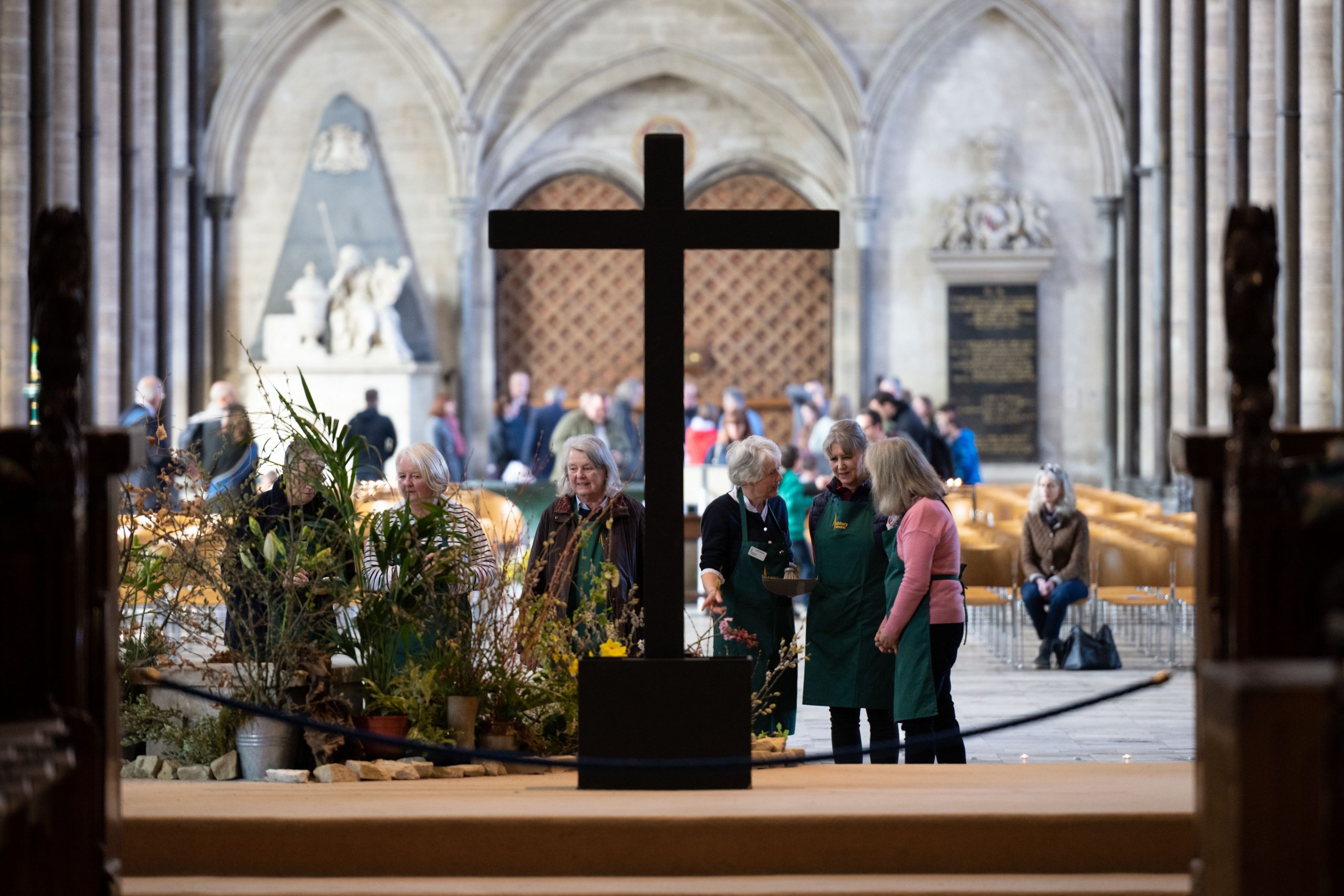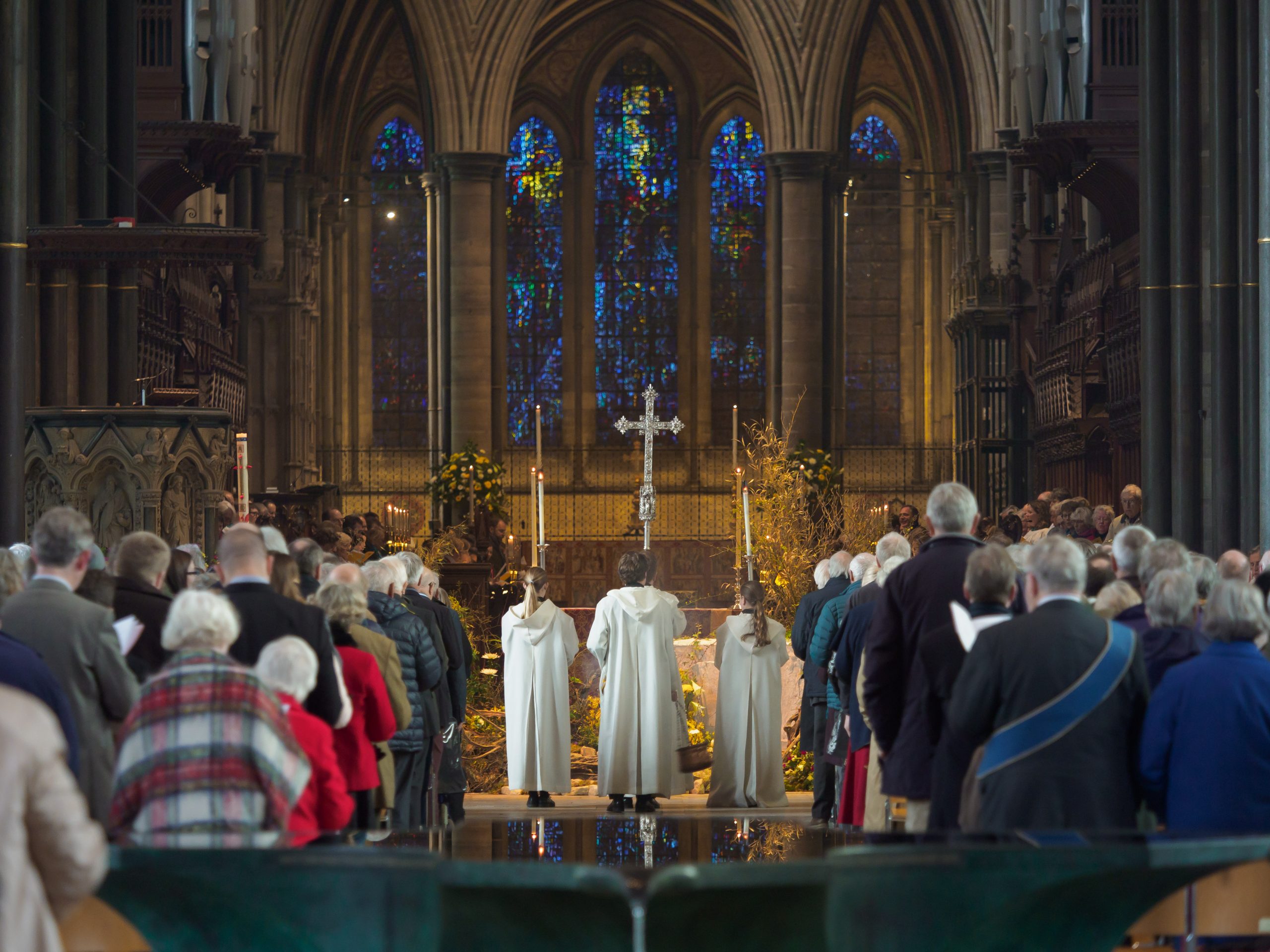For whom are you looking?

Sunday 9 April 2023, Easter Sunday, 10.30am Easter Day Eucharist
Acts 10: 34-43
John 20: 1-18
For whom are you looking? Sermon given by The Very Revd Nicholas Papadopulos, Dean of Salisbury
‘Jesus said to her, “Woman, why are you weeping? For whom are you looking?”’
Jesus puts to the grieving Mary Magdalene the very same question that he puts to the soldiers who come to the garden to arrest him. ‘For whom are you looking?’ The one who has come to mourn him is met with the words that those who have come to harm him are met.
The soldiers are looking for Jesus of Nazareth. Mary Magdalene is looking for the body of Jesus of Nazareth. But mourner and armed men all find more than they are looking for. When Jesus confirms to the soldiers ‘I am he’ they step back and fall to the ground, for Jesus has called himself by the very name of God. When Mary asks the supposed gardener whether he has removed the body, she hears the voice of Jesus himself.
The one that Mary finds – the one that the soldiers find – is greater than the one that she or they have gone looking for. ‘For whom are you looking?’ The question uncovers the respondents’ limited imagination, shaky faith, and non-existent hope.
On Monday in Holy Week Canon Kenneth challenged those of us who heard his Compline Address to come up with an elevator pitch: a pithy phrase that we would use if we needed to give an account of our faith in the few seconds that might elapse between haberdashery on the second floor and kitchenware in the basement. There’s no point in reinventing the wheel and, without hesitation, my elevator pitch would be that composed by David Jenkins, the former Bishop of Durham. I don’t think it’s ever been bettered: ‘God is as God is in Jesus. So there is hope’. God is as God is in Jesus. So there is hope.
It is this that Mary discovers on the first Easter morning. She has come looking for a corpse, but she finds that her Lord, who was dead, has been raised. He is looking her in the face, and he is calling her by her name. God is, and God is as God is in Jesus: in the garden of Gethsemane, faithful to death; on the hill of Calvary, faithful through death; now, on Easter morning, faithful still: knowing her; loving her; calling her. What she most wants, what she most desires, what she is most urgently looking for – all this she finds, but what she finds exceeds everything she has wanted, desired, or looked for. Her limited imagination, shaky faith, and non-existent hope – her conviction that this gardener has removed the body – are displaced in a moment.
For whom are you looking? With what imagination, faith, and hope have you come here this morning? Perhaps with sense of duty, perhaps with a pang of dread. Perhaps with secret fear, or perhaps with bright hope. Perhaps with crushing pain, or perhaps with abundant joy. For what are you looking? Own it in your hearts as you approach the altar today; name it; articulate it; be ready to tell it to the risen Lord. And remember that although the promise of Easter is that what you seek you will find, the paradox of Easter is that you may not know it when you do. For what you will find is beyond mortal power to own or to name or to articulate. What you will find is God – as God is in Jesus.
I’ll be honest. It may not feel like that. The fear, the pain, and the dread may linger; the hope and the joy may wilt (although that’s not our intention!) But God is not an experience, not in any lasting sense. Today’s worship may be a good experience, like the Simnel cake and chocolate eggs of Easter Day. But experiences and the feelings they induce in us come and go. God does not. The God who you will find here will be found where he always is found, week after week, year after year. God is here in the words of Scripture read; God is here in the company of those assembled with you; and God is here above all in the bread and wine of Holy Communion. These gifts – Scripture, Church, sacrament – are the assurance of his risen, living, abiding presence with us; these gifts are given to us at no cost; these gifts will accompany us through life and through death; these gifts are the foretaste of a banquet that awaits. This is what hope looks like.
And like Simnel cake and chocolate eggs, these gifts of hope are best enjoyed when they are shared. On fire with the revelation she has received Mary and goes and announces to the disciples ‘I have seen the Lord’. She risks their scorn, and tells them what Jesus has told her. It’s what the poet Wendell Berry means when he urges us ‘Practice resurrection’. If that sounds a bit beyond us he adds:
‘Say that the leaves are harvested
when they have rotted into the mold.
Call that profit. Prophesy such returns.
Put your faith in the two inches of humus
that will build under the trees
every thousand years’.
God is as God is in Jesus. Life has come out of death; light has come out of darkness; hope has come out of despair. This truth is written into every sunrise that succeeds a sunset, into every spring that succeeds a winter, into every forkful of last year’s compost that we dig into this year’s vegetable patch, into every effort we make to recycle, rewild, and renew. How could we possibly miss it? Practice resurrection, for our dying is not the end of our living; in fact, in our dying is the source of our living.
God is as God is in Jesus. So there is hope. Christ is risen. Alleluia, alleluia, alleluia.




